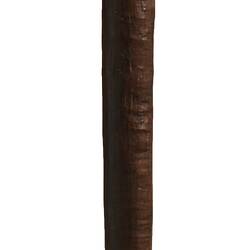Summary
Aboriginal men throughout New South Wales used a range of clubs that varied in size, shape and material. David Collins (1756-1810), the deputy judge advocate for the new colony at Botany Bay, listed eight names for clubs primarily used as weapons: woodah, cannatalling, doowinnul, cannicull, carruwang, womurrang, gnallungulla and tarrilberre. The gnallungulla (now spelt ngalangala) has a long straight shaft and characteristically features a cone-shaped head with a sharp point. It was aptly named using the Dharawal word meaning 'mushroom'.
Local Name
Ngalangala
Physical Description
Club made of She-oak with a circular cone shaped head and a long straight shaft with a slightly cone shaped handle. Surfaces are smooth and undecorated. There are small chips along edges of the head of the club.
Significance
Colonial artists George Raper, Joseph Lycett and the 'Port Jackson Painter' depicted ngalangala (clubs) from the Port Jackson locality. These ngalangala featured inverted heads, decorated on the flat topside with red and white stripes from the centre. Undecorated ngalangala such as this one have been found throughout New South Wales, including on Cumberland Plain, at a vineyard near Windsor, on the northern shore of Port Jackson and at San Pan Creek near Peakhurst, the latter attributed as coming from Woollongong.
More Information
-
Object/Medium
Club
-
Maker
-
Locality
-
Date Produced
-
Collector
-
Object Measurements
730 mm (Length), 140 mm (Width), 125 mm (Height)
-
Classification
-
Date Made
-
Maker
-
Clan/Language Group
-
Place Made
-
Indigenous Region
-
Keywords
-
Collection Names
-
Type of item
-
Discipline
-
Category
-
Collecting Areas



